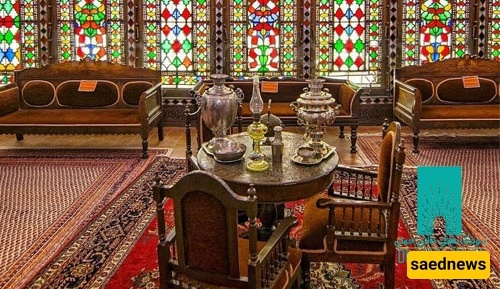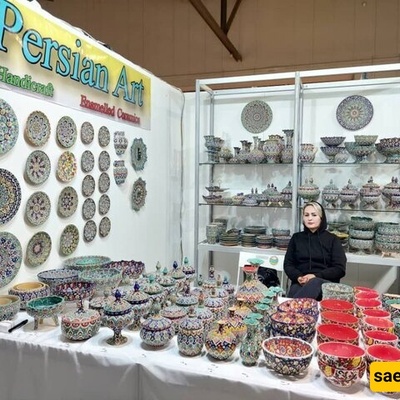Saed News: Stay with us as we explore the unique and breathtaking decor and architecture of the most beautiful house in Isfahan.

According to the Tourism Service of Saed News, Molla Bashi House in Isfahan is a historic residence that was registered as a national heritage site in 2002 (1381 in the Iranian calendar) and is located in the center of Isfahan city, on Hasht Behesht Street. The Molla Bashi House, also known as Motamedi House (owned by the Motamedi family in recent decades), contains elements from the Safavid, Zand, and Qajar eras. Although the exterior façade and courtyard are not particularly surprising, visitors are captivated by its attractive decor and architecture upon entering the hallway to the interior. The stained glass windows and mirrored walls are part of the house’s outstanding architecture. The remarkable stucco decorations among the colorful tiles that adorn the ceiling give the place a stunning appearance.
Each room in Molla Bashi House in Isfahan has a unique and impeccable decor. The paintings, stained glass, mirrored walls, and inscriptions showcase the architectural differences between the Qajar and Safavid periods well. The Motamedi family dedicated over seven years to restoring Molla Bashi House in Isfahan to make it accessible to visitors. One of the unique features of this house is that all the rooms are carpeted, and the presence of Iranian carpets gives visitors a real sense of being at home.


Molla Bashi House was one of the houses that survived massive destruction during the time of Zol-Soltan, the son of Naser al-Din Shah, one of the Qajar kings, in Isfahan. Zol-Soltan was notorious for the destructions carried out under his orders. The house was purchased by a famous astronomer named Molla Bashi, who took good care of this historic building. Molla Bashi was the astronomer of Naser al-Din Shah Qajar, sent on a mission to Isfahan. In 2000 (1379), the house was acquired by the Motamedi family, hence it is also called Motamedi House.

Molla Bashi was the astronomer of Naser al-Din Shah who was sent on a mission to Isfahan. The story of Molla Bashi House dates back to the Qajar period and the reign of Zol-Soltan, the eldest son of Naser al-Din Shah Qajar, in Isfahan. Zol-Soltan was not selected as crown prince because he was born of a non-Qajar mother. This caused him to develop complexes and behaviors aimed at asserting his power. Among his actions was creating an army dressed like Austrian soldiers and hiring German instructors to train them in combat techniques.
Zol-Soltan either completely destroyed or nearly destroyed all Safavid-era monuments. Perhaps most surprisingly, he also caused great damage to Iran’s nature in the Miankaleh region. Many native animals such as the Maral deer and Caspian tiger were completely wiped out there.

Due to Zol-Soltan’s destructive and unconventional behaviors, his faithful wife protested. She moved to live in the house of Agha Najafi Akhound, an official and trusted figure in Isfahan at the time, to express her opposition. Agha Najafi Akhound’s house, now known as the Constitutional House, is only a 15-minute walk from Molla Bashi House, so the two houses are very close to each other.

Later, Zol-Soltan gathered all his sons and told them that whoever kills their mother will inherit half of his properties! This event caused unrest and tension in Isfahan, which led to Molla Bashi being called to Isfahan. Molla Bashi was a moderate religious figure who was summoned to calm the tense situation.

Molla Bashi House in Isfahan is an attractive example of traditional Iranian houses in Isfahan. Like other Iranian houses and mansions, it is divided into two parts: the “andaruni” (private section) and the “biruni” (public section). When Molla Bashi acquired the house, it consisted of a five-door room and a winter room. After the purchase, the “shahneshin” (royal sitting rooms) were added to the mansion.
The house is located on Hasht Behesht Street, Melk Shomali Street, in Isfahan. It is only about a 10-minute drive from the historic Si-o-se-pol Bridge.






